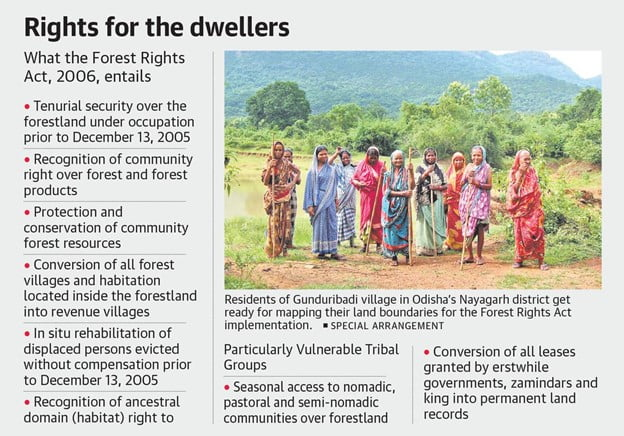Description

Copyright infringement not intended
Picture Courtesy: https://sabrangindia.in/key-hurdles-implementing-forest-rights-act-gujarat-experience-ground/
Context: A fact-finding committee examined the implementation of the Forest Rights Act (FRA) 2006 in five states: Assam, Chhattisgarh, Maharashtra, Odisha, and Karnataka.
Key Highlights of the Report
- The Forest Rights Act (FRA) of 2006 has been implemented differently in five Indian states—Assam, Chhattisgarh, Maharashtra, Odisha, and Karnataka—according to the findings of the fact-finding committee set up by Call for Justice.
Jhum cultivation
- The current FRA does not recognise "jhum" (shifting cultivation) in the northeast, despite its cultural and ecological significance.
- Jhum involves cutting down parts of forests for cultivation and then letting them lay fallow for several years while the flora regenerates. This cyclical activity has evolved to meet the region's unique ecological restrictions and is deeply rooted in the cultural character of many communities.
- The committee emphasised the importance of finding a mechanism for integrating jhum cultivation into the FRA's framework.
Bureaucracy
- Gram sabhas (village councils) have limited power to recognise rights. District committees exercise real authority, causing delays. The governmental procedure of recognising forest rights can be slow and complicated.
- The report highlights that this power imbalance causes delays since claims must be accepted by district-level committees, which may be far away and unresponsive to the concerns of local populations.

Slow Progress
- Chhattisgarh has a slow decision-making process. The reasons are uncertain. The committee discovered that the process of recognising forest rights claims in Chhattisgarh's Kanker and Korba districts was severely delayed.
- The report does not go into detail about the causes for the delay, but it indicates that a lack of clarity or capacity at the district level could be a contributing factor.
Uneven recognition
- Recognition rates vary greatly. Gadchiroli in Maharashtra serves as an example for community rights, but Nashik falls behind. Recognition rates for forest rights claims differed greatly across the five states investigated.
Gap Between Claims and Recognition
- In Odisha's Kandhamal and Sundargarh districts, there was a significant gap between the number of individual forest rights (IFR) and community forest rights (CFR) applications submitted and those that were ultimately recognised. This indicates that the process of examining and approving claims may be backlogged or inefficient.
Land Allocation Issues
- Karnataka had the highest percentage of rejection of individual forest rights claims among the states surveyed. Even for granted claims, the average land allocation was about 0.8 acres. This small plot size makes it impossible for claimants to live on their property.

Limited attention to community rights
- Many authorities are unclear about the distinction between community and individual rights. The report highlighted a lack of clarity among several government institutions regarding the distinction between individual and communal forest rights. This misconception might cause claims to be processed slowly and incorrectly.
Exclusion of Other Traditional Forest Dwellers
- People who are not classified as Scheduled Tribes are left out of the process. The FRA primarily acknowledges the rights of Scheduled Tribes and Other Traditional Forest Dwellers. However, the report highlighted that people who qualify as Other Traditional Forest Dwellers (OTFDs) but are not classified as Scheduled Tribes are excluded from the FRA recognition procedure. This raises issues of equity and justice for these communities.

Conclusion
- The report emphasises the importance of streamlining and improving the Forest Rights Act's implementation, particularly in terms of recognising community rights, removing bureaucratic barriers, and ensuring the inclusion of all eligible forest-dwelling communities, including other traditional forest dwellers.
Must Read Articles:
RIGHTS OF FOREST DWELLERS: https://www.iasgyan.in/daily-current-affairs/rights-of-forest-dwellers
FOREST CONSERVATION RULES, 2022 VS FOREST RIGHTS ACT, 2006: https://www.iasgyan.in/daily-current-affairs/forest-conservation-rules-2022-vs-forest-rights-act-2006#:~:text=The%20Forest%20Rights%20Act%20
|
PRACTICE QUESTION
Q. Evaluate the practical issues that authorities and forest-dwelling communities encounter while claiming and securing their rights under the Forest Rights Act (FRA).
|












